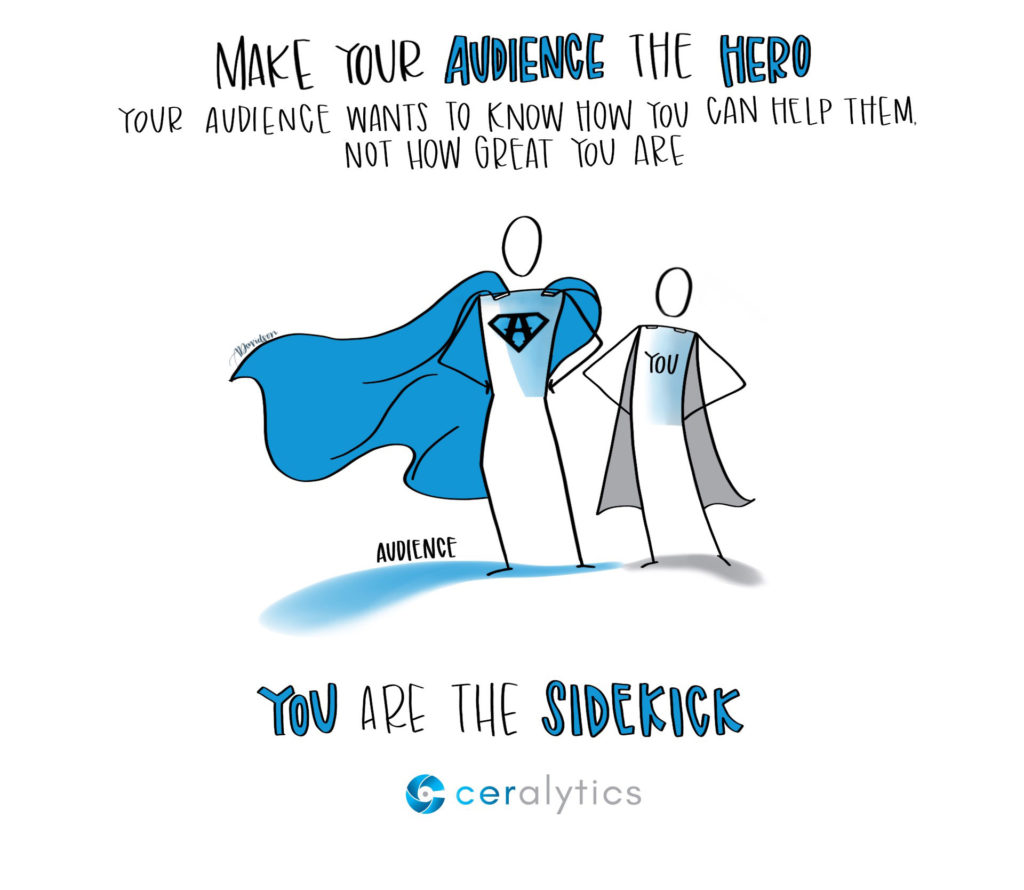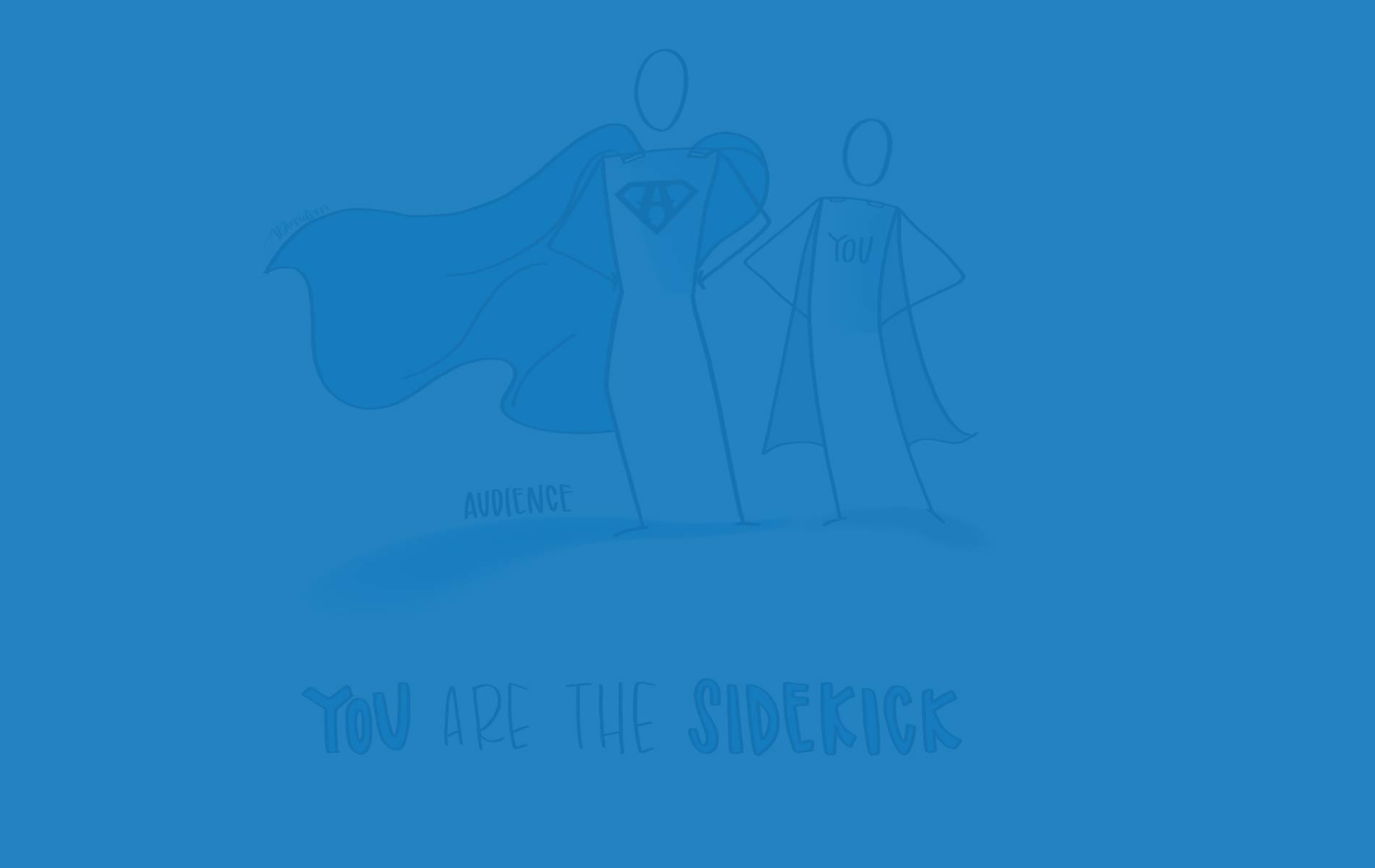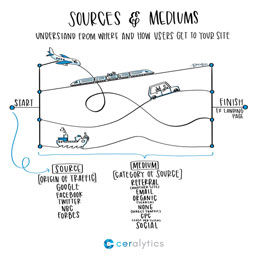Creating engaging content is the hardest it’s ever been. You’re competing against everything else online for your audience’s attention.
To write engaging content that pulls your audience in, develops trust, and shows them that you understand their pain points, you need to make your audience the hero of the story, and make yourself their sidekick.

As marketers and business leaders, we see ourselves as superheros – out there providing goods and services that people need to make their lives better. We are confident in what we do and stand tall above our competition, waiting to save yet another customer who stumbles upon us.
A lot of the time, that’s how we write our content too. We focus on how we will swoop in and save that customer time, money, frustration, or any number of other things that need saving.
For example:
“Our product does X, Y, and Z. It reduces costs, increases revenue, and streamlines processes.”
Or …
“We are pleased to announce our newest feature that will provide A, B, and C at a fraction of the cost of our competition.”
This approach can come across as off-putting or downright annoying.
Our marketing superhero complex
When positioning ourselves against our competition, it’s easy to get caught up in a bit of boasting. Aside from the obvious boasts of “industry-leading”, “award-winning” and “most successful”, we also fail to realize that we spend a lot of time talking about features and benefits.
You might ask, “But, shouldn’t we be focusing on features and benefits? That’s what we’re selling, right?”
No. You are selling a transition for your customer. You’re getting your audience from a pain state to a resolved state – hopefully even to an elated state.
Saving people from pain seems like something a superhero should do. But it doesn’t work when the person being saved sees themselves as the superhero of their own story.
The painful truth that marketers need to realize is that no one actually gives a $#!% about your brand.
Your audience is the hero
Your audience is the hero of their own story. They are not looking to be rescued. They are looking for guidance.
Your audience wants to transition from pain to a better state. This pain was caused by something that came up and knocked them out of their normal routine. The key is to understand what that pain point really is, and what got them to the state that they are in. Then approach your content from their point of view.
The marketing/sales-centric superhero approach in action
When a customer goes into a home improvement store and asks for a drill, the clerk could show them all of the features of all of the drills they have. The clerk could tell them all of the benefits of the drills – some are cordless so you have more mobility, some are hammer drills so you can drill through masonry, etc. The clerk could spend a lot of time talking up these features and benefits.
This is how most of us approach marketing and sales. We think the pain point is that the person wants a drill, so we’re going to show them how great the drills we have are.
But what the person actually wants isn’t a drill. What they want is to put a hole in something. The clerk never got to the underlying pain point, and instead tried to position the drills as the solution to the perceived problem. If the clerk would have put himself/herself in the customer’s shoes, the approach becomes very different.
The customer-centric superhero approach
In reality, clerks at home improvement stores usually do a great job of asking about the project or goal the customer has. They are trained to do this. They put themselves securely in the helper role and guide the client to be their own hero.
The clerk will ask what the project is, and will understand that not only does someone want to put a hole in something, but that they need to put holes in something so they can hang a new wire shelf in a pantry.
The clerk, by knowing the customer’s true pain points, can now assist in more than just getting the right drill for the job. They can also recommend other items to help, such as the right wall anchors, drill bits, and drywall putty. Not only does this help increase sales for the company, but it gives the customer everything they need to go home and be the hero who finished the project without tearing up their wall.
That’s what makes home improvement stores amazing compared to other big box stores.
Examples of customer-as-a-hero language
Marketing as the hero: “This drill has multiple speeds, and 15 clutch settings to stop the drill when the torque gets too high.”
Customer as the hero: “Never over-tighten or strip another screw, because this drill will automatically stop when the screw is secure.”
Did you spot the difference? It’s not only in focusing the attention to be audience-focused, but it’s telling them that they will never over-tighten or strip another screw. That makes the customer a hero – they are now better at what they set out to do thanks to the tool.
Marketing as the hero: “The 20v battery will last 8 hours on a single charge.”
Customer as the hero: “Work the whole day without having to worry about changing or charging batteries.”
The change is subtle here, but it’s painting the picture of someone who doesn’t have to lose time to change or charge a battery. That time wasted is a pain point that is addressed directly without it being about the drill.
Next steps to take
Take 20 minutes to look at your website copy. Who is it really written for? Mentioning your product and your brand is fine, but are you talking to pain points that your customers have, or are you focused on features?
Now re-imagine that copy flipped, making your audience the hero and you being the sidekick. How does the copy change? How does the mood change?
We’ve been taught for decades to write about features and benefits. It’s hard to move past that mindset. But if we’re to create truly engaging content and build trust with our audiences moving forward, it’s imperative that we make this leap.
About Sketchalytics
Each week we send out a micro-lesson in marketing and/or business.
Our goal is NOT to give you best practices to go out and do what other people do. You can get that anywhere.
Instead, our goal is to give you knowledge that you can apply to your own organization to make the best decisions possible.
If you know anyone who you think would benefit from Sketchalytics, please feel free to share this with them so they can sign up.


